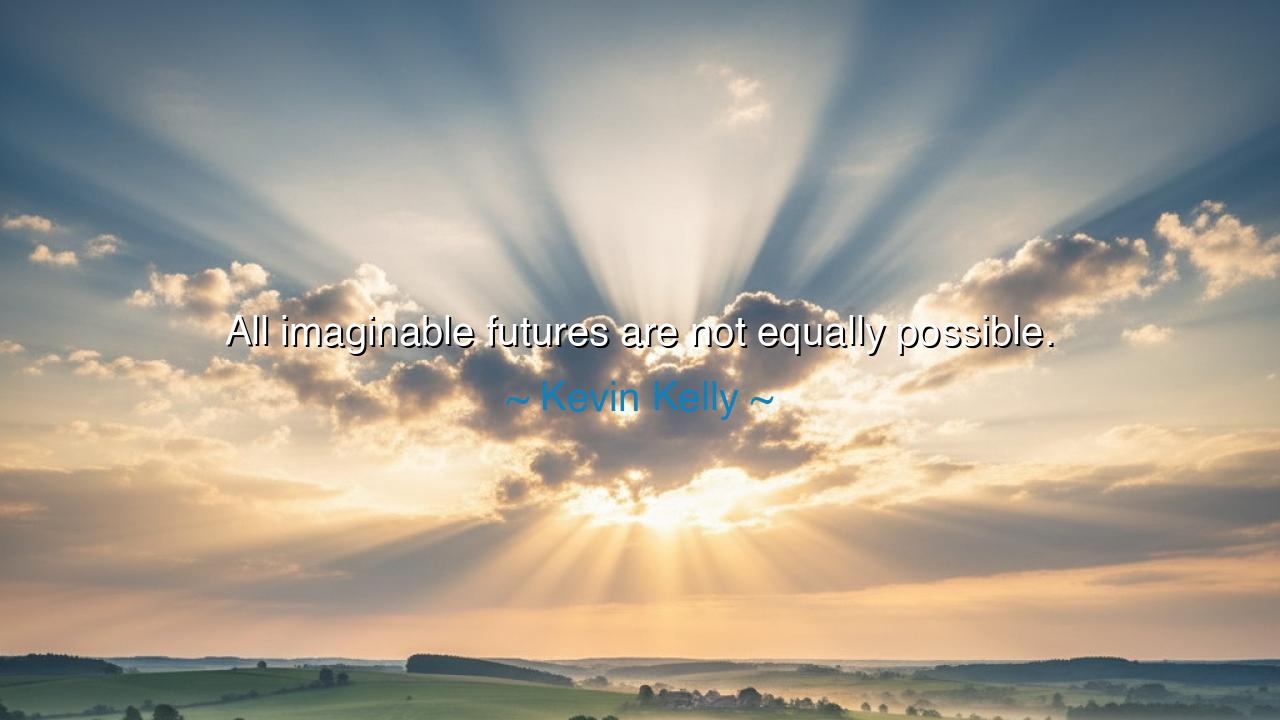
All imaginable futures are not equally possible.






Hear now the words of Kevin Kelly, the visionary of the digital age and seer of technology’s unfolding destiny: “All imaginable futures are not equally possible.” This is no idle statement, but a truth whispered by time itself—a truth that bridges the dream and the real. In this saying lies the wisdom of discernment: that while human imagination may be infinite, the pathways of reality are shaped by forces greater than desire—by law, by nature, by consequence, and by the subtle gravity of what already exists.
In the ancient days, philosophers spoke of fate and free will as two rivers merging into one. They taught that destiny is not fixed, yet not wholly free. Kevin Kelly, though of a modern age, speaks with that same eternal insight. He reminds us that though our minds can conceive infinite futures, not all may come to pass. The seed of possibility must fall upon the soil of reality, and only those dreams rooted in truth will grow. The dreamer may imagine wings of wax, but the sun of consequence will test whether they can fly.
This wisdom was revealed again in the story of Leonardo da Vinci, the master of visions. He sketched flying machines, submarines, and inventions centuries before their time. Yet many of his designs never took flight, for the world was not yet ready—the metals too weak, the engines unborn. Leonardo dreamed of futures that were imaginable, but not yet possible. Still, his imagination was not in vain; for he laid the stones upon which others would later build. Thus, Kelly’s words remind us that timing and readiness are as vital as vision. A future is not only to be imagined—it must also be prepared for.
So, children of tomorrow, do not despair that not every dream can live. For the fabric of existence is woven with both constraint and freedom, and wisdom lies in knowing their measure. The foolish dreamer demands that the universe bend instantly to his will; the wise creator studies the forces around him, learns their language, and builds within their rhythm. The possible future does not bow to imagination alone—it responds to patience, knowledge, and effort.
Consider also the builders of the internet, who in the 20th century dreamed of a web that would unite humankind. They imagined a network of learning and peace. Yet the reality that emerged was both wondrous and perilous—a mirror of humanity’s own heart. The dream was possible, but imperfect. And so it shall always be: for every future that dawns, others must fade, and every light casts a shadow. Kelly’s words call us, then, not to dream less, but to dream wisely—to know that imagination is the compass, but reality is the terrain.
This teaching humbles and empowers alike. It tells us that vision without action is illusion, but also that limitation without imagination is stagnation. Between the two, life unfolds. The artist, the scientist, the builder—all must dwell in that tension, crafting futures that can live, not just be dreamed. To understand that “all imaginable futures are not equally possible” is to walk the path of maturity: to see not only what could be, but what may truly come to be through wisdom, persistence, and harmony with the world.
Therefore, let this lesson take root within you. Dream as vast as the heavens, but build as steady as the earth. Study what is, so you may shape what might be. Do not waste your strength chasing the impossible horizon, yet never cease to expand the boundaries of what is possible. For within every generation lies the power to make one new future real—if it learns to unite imagination with truth.
And when you look toward the unseen tomorrow, remember the voice of Kevin Kelly: the universe is generous, yet not without order. Dream boldly, but discern deeply. For though all imaginable futures may shine in the mind’s eye, only those aligned with the currents of life itself shall ever be born into light.






AAdministratorAdministrator
Welcome, honored guests. Please leave a comment, we will respond soon